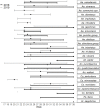Outbreak Investigation: Jamestown Canyon Virus Surveillance in Field-Collected Mosquitoes (Diptera: Culicidae) From Wisconsin, USA, 2018-2019
- PMID: 35530736
- PMCID: PMC9068969
- DOI: 10.3389/fpubh.2022.818204
Outbreak Investigation: Jamestown Canyon Virus Surveillance in Field-Collected Mosquitoes (Diptera: Culicidae) From Wisconsin, USA, 2018-2019
Abstract
During the summers of 2017-2019, 60 human cases of Jamestown Canyon virus-associated disease were reported in the State of Wisconsin, U.S.A; by comparison, there were 28 cases in the 5 years prior. Jamestown Canyon virus (JCV, Peribunyaviridae: Orthobunyavirus) is a zoonotic, mosquito-borne virus that is endemic throughout North America. The proposed transmission cycle for JCV involves horizontal transmission by a variety of mammal-feeding mosquito species and deer hosts, and transseasonal maintenance by vertical transmission in Aedes mosquito species. Although some of the earliest work on JCV transmission and disease was done in Wisconsin (WI), little is known about the spectrum of mosquitoes that are currently involved in transmission and maintenance of JCV, which is key to inform the approach to control and prevent JCV transmission, and to understand why case numbers have increased dramatically in recent years. Therefore, we undertook an intensive surveillance effort in Sawyer and Washburn counties, WI between April and August of 2018 and 2019, in an area with a concentration of JCV human cases. Larval and adult stages of mosquitoes were surveyed using larval dippers and emergence traps, light traps, resting boxes, a Shannon-style trap, and backpack aspirator. In total, 14,949 mosquitoes were collected in 2018, and 28,056 in 2019; these specimens represent 26 species in 7 genera. Suspect vector species were tested for JCV by polymerase chain reaction (PCR); of 23 species that were tested, only Aedes provocans yielded JCV positive results. In 2018, a single pool of Ae. provocans tested positive. In 2019, with more focused early season surveillance, we detected JCV in 4 pools of adult mosquitoes, and one pool that consisted of lab-raised adults that were collected as larvae. Material from all of these PCR-positive samples also yielded infectious virus in cell culture. Overall, these data provide new insight into the seasonality and habitat preferences for 26 mosquito species in Northern WI, which will be useful to inform future surveillance efforts for JCV. The results underscore the importance of Ae. provocans as a vector species involved in transseasonal maintenance of JCV in this region.
Keywords: Aedes provocans; Midwest USA; arbovirus; spring Aedes; vertical transmission.
Copyright © 2022 Farquhar, Thrun, Tucker and Bartholomay.
Conflict of interest statement
The authors declare that the research was conducted in the absence of any commercial or financial relationships that could be construed as a potential conflict of interest.
Figures

Similar articles
-
California Serogroup Viruses in a Changing Canadian Arctic: A Review.Viruses. 2023 May 25;15(6):1242. doi: 10.3390/v15061242. Viruses. 2023. PMID: 37376542 Free PMC article. Review.
-
Jamestown Canyon virus (Bunyavirales: Peribunyaviridae) vector ecology in a focus of human transmission in New Hampshire, USA.J Med Entomol. 2023 Jul 12;60(4):778-788. doi: 10.1093/jme/tjad046. J Med Entomol. 2023. PMID: 37071925
-
Isolations of Jamestown Canyon virus (Bunyaviridae: Orthobunyavirus) from field-collected mosquitoes (Diptera: Culicidae) in Connecticut, USA: a ten-year analysis, 1997-2006.Vector Borne Zoonotic Dis. 2008 Apr;8(2):175-88. doi: 10.1089/vbz.2007.0169. Vector Borne Zoonotic Dis. 2008. PMID: 18386967
-
Jamestown Canyon virus comes into view: understanding the threat from an underrecognized arbovirus.J Med Entomol. 2023 Nov 14;60(6):1242-1251. doi: 10.1093/jme/tjad069. J Med Entomol. 2023. PMID: 37862091 Review.
-
Jamestown Canyon Virus in Collected Mosquitoes, Maine, United States, 2017-2019.Emerg Infect Dis. 2022 Nov;28(11):2330-2333. doi: 10.3201/eid2811.212382. Emerg Infect Dis. 2022. PMID: 36286231 Free PMC article.
Cited by
-
California Serogroup Viruses in a Changing Canadian Arctic: A Review.Viruses. 2023 May 25;15(6):1242. doi: 10.3390/v15061242. Viruses. 2023. PMID: 37376542 Free PMC article. Review.
-
Public health significance of the white-tailed deer (Odocoileus virginianus) and its role in the eco-epidemiology of tick- and mosquito-borne diseases in North America.Parasit Vectors. 2025 Feb 6;18(1):43. doi: 10.1186/s13071-025-06674-6. Parasit Vectors. 2025. PMID: 39915849 Free PMC article. Review.
-
Surveillance and Genetic Analysis of Jamestown Canyon Virus in New York State: 2001-2022.Am J Trop Med Hyg. 2023 Oct 9;109(6):1329-1332. doi: 10.4269/ajtmh.23-0392. Print 2023 Dec 6. Am J Trop Med Hyg. 2023. PMID: 37972332 Free PMC article.
-
Snowshoe hare virus: discovery, distribution, vector and host associations, and medical significance.J Med Entomol. 2023 Nov 14;60(6):1252-1261. doi: 10.1093/jme/tjad128. J Med Entomol. 2023. PMID: 37862052 Free PMC article.
-
Clinical Characteristics and Outcome of Jamestown Canyon Virus Infection in Hospitalized Wisconsin Patients.Open Forum Infect Dis. 2025 Jul 29;12(7):ofaf360. doi: 10.1093/ofid/ofaf360. eCollection 2025 Jul. Open Forum Infect Dis. 2025. PMID: 40735330 Free PMC article.
References
-
- Centers for Disease Control Prevention . Jamestown Canyon virus Statistics & Maps U.S. Department of Health & Human Services: USA.gov. (2021). Available online at: https://www.cdc.gov/jamestown-canyon/statistics/index.html (accessed November 16, 2021).
Publication types
MeSH terms
Grants and funding
LinkOut - more resources
Full Text Sources
Miscellaneous

